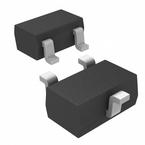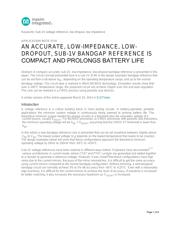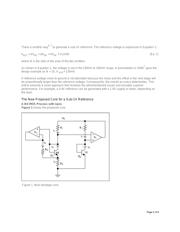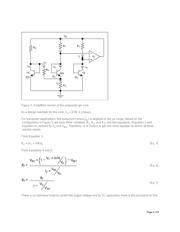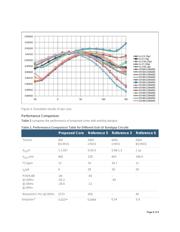下载

Keywords: Sub-1V voltage reference, low dropout, low impedance
APPLICATION NOTE 5710
AN ACCURATE, LOW-IMPEDANCE, LOW-
DROPOUT, SUB-1V BANDGAP REFERENCE IS
COMPACT AND PROLONGS BATTERY LIFE
Abstract: A compact, accurate, sub-1V, low-impedance, low-dropout bandgap reference is presented in this
paper. The circuit concept presented here is a sub-1V (0.9V in the design example) bandgap reference that
can be set from a bit above V
, depending on the operating temperature range, and up to the normal
bandgap voltage. The circuit idea is realized in 90nm BiCMOS technology. Simulation results show that
over a
200°C temperature range, the proposed circuit can achieve 15ppm over line and load regulation.
The core can be realized in a CMOS process using parasitic pnp devices.
A similar version of this article appeared March 10, 2014 in ELETimes.
Introduction
A voltage reference is a critical building block in most analog circuits. In battery-operated, portable
applications the minimum system voltage is continuously being lowered to prolong battery life. The
theoretical minimum supply needed for analog circuitry is a threshold plus the saturation voltage of a
current source, usually V
. For BiCMOS processes, or CMOS processes with parasitic pnp transistors,
the minimum operating voltage will be V
+ V , assuming that the CMOS VT threshold is lower than
V
.
In this article a new bandgap reference core is presented that can be set anywhere between slightly above
V
to V . The lowest output voltage (V ) depends on the lowest temperature that needs to be covered.
The design examples below will show that these configurations approach the theoretical minimum
operating voltage by 50mV to 100mV from -50°C to +150°C.
Sub-1V voltage references have been realized in different ways before. Engineers have documented
various architectures in current mode, where CTAT and PTAT currents are generated and added together
to a resistor to generate a reference voltage. However, it was shown that those configurations have high
noise due to the current mirrors. Because of the mirror mismatches, it is difficult to get the same accuracy
using current mirrors compared to the normal bandgap configuration. Without trimming, a well-designed
bandgap circuit can normally achieve 3% to 5% 6δ accuracy from -40°C to +125°C. Even with a reasonably
high overdrive, it is difficult for the current mirrors to achieve this level of accuracy. If overdrive is increased
for better matching, it also increases the necessary headroom as V
is increased.
BE
DSSAT
BE DSSAT
BE
BE BG 0
1–5
6
DSSAT
Page 1 of 8

